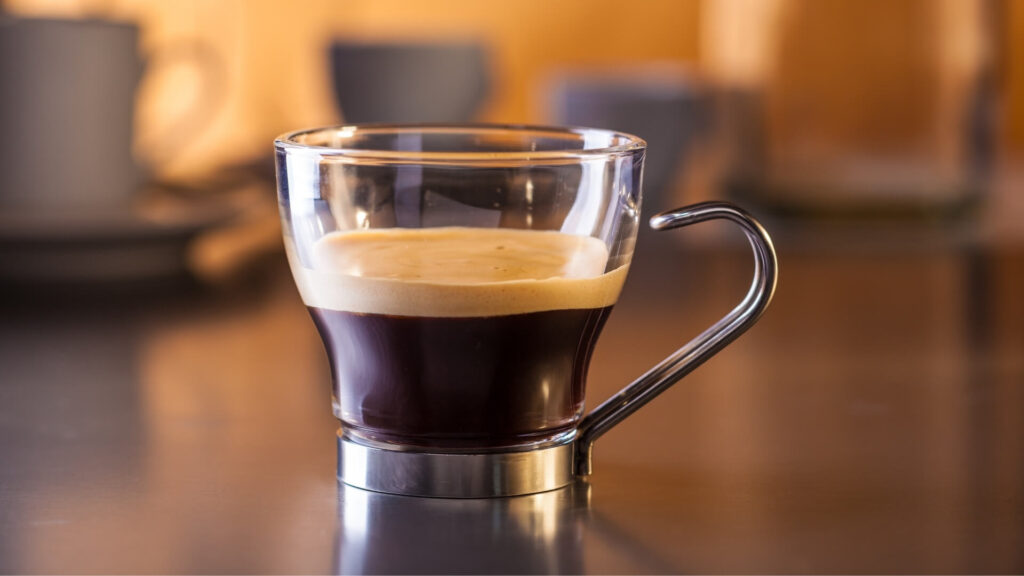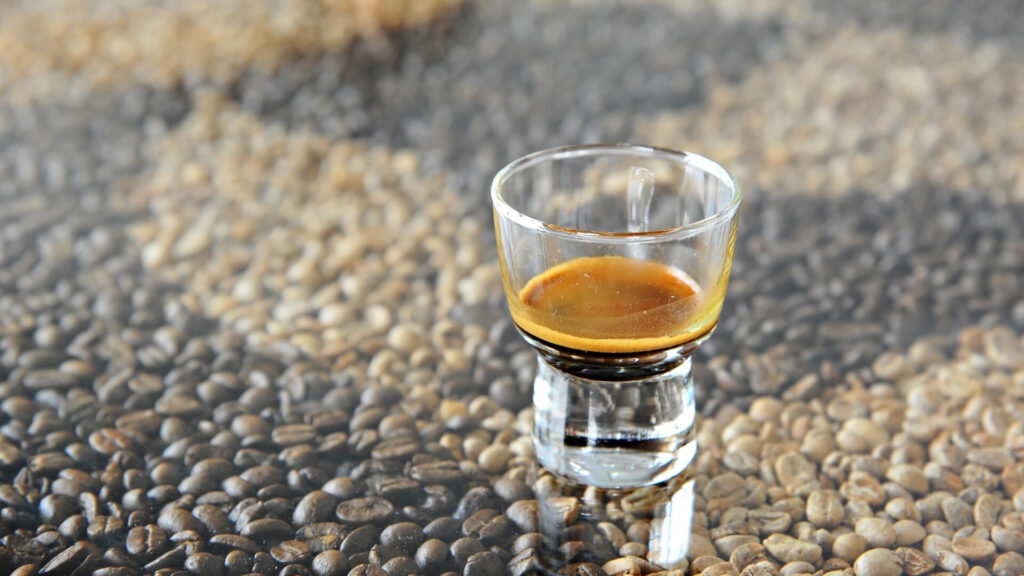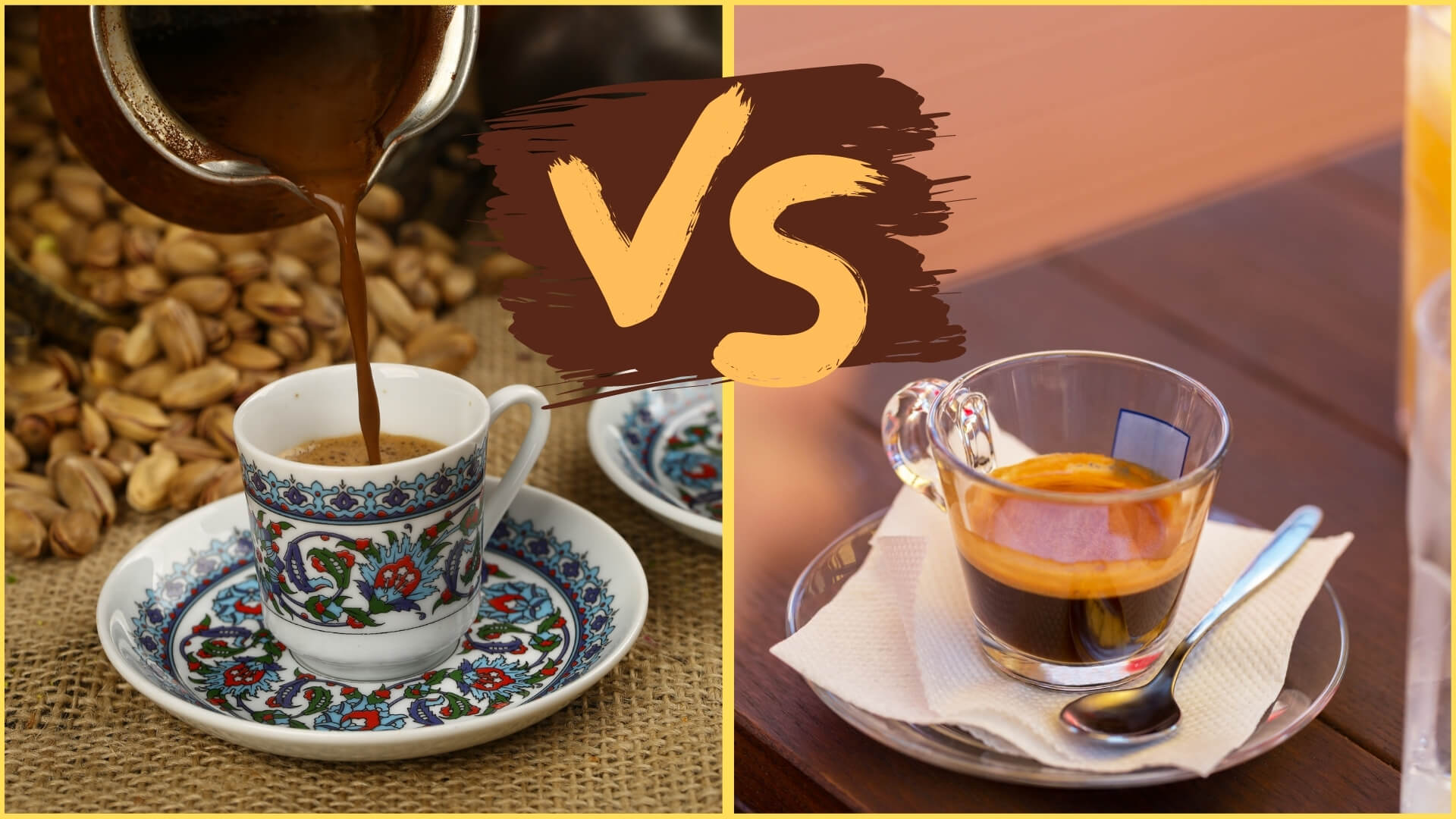In this article, I will share my knowledge about ristretto coffee and explain why it’s stronger than espresso.
Ristretto coffee is the perfect drink for those who want to enjoy a stronger taste of espresso with less caffeine.
What is ristretto? It’s an Italian word that describes short, intense bursts of coffee from a small number of grounds. This means that it has less caffeine than an espresso, but more flavor-and the perfect way to enjoy your morning cup!
Want to learn more about Ristretto? Here we go!
Let’s start with learning more about Espresso as it’s crucial in understanding the whole concept.
- What is Espresso Coffee?
- What is Ristretto Coffee?
- 10 Key Differences Between Espresso And Ristretto
- Shot of Espresso vs Ristretto: What’s The Taste?
- Is Ristretto Stronger Than Espresso?
- Espresso vs Ristretto: Which is better?
- What Are The Best Coffee Beans For Making Ristretto?
- Ristretto vs Long Shot
- Some questions you may have
- Conclusion
What is Espresso Coffee?

To understand what Ristretto is we need to learn a bit about espresso as they are closely related.
The term “espresso” is a generic word for coffee brewed by forcing steam or water under pressure through finely-ground coffee. The result is a strong, slightly sweet cup of coffee with a thick foam on top.
Espresso coffees are usually served in small cups called espresso cups and can be either drunk straight or used as an ingredient in other drinks such as the cappuccino.
The word “espresso” comes from the Italian language, meaning “pressed out”. This refers to the process of making espresso: forcing hot pressurized water through finely-ground beans that have been compacted into a dense puck shape.
Read next: Why is espresso served with sparkling water?
What is Ristretto Coffee?

Ristretto, meaning “restricted” or “tightened up”, is a type of espresso that differs from the traditional double or single shots of espresso. It’s made by forcing steam or water under pressure through finely-ground beans for a shorter period of time.
The result is a concentrated shot with less foam and more flavor. A ristretto generally contains one to two ounces (30 to 60 ml) of liquid versus the usual 2 to 3 ounces (60 to 90 ml) in a standard cup.
Some people prefer it because they think it has more body and better taste than regular espressos. Others say that it just tastes weaker because not as much water passes through the coffee.
10 Key Differences Between Espresso And Ristretto
| Aspect | Ristretto | Espresso |
| Coffee-to-Water Ratio | Higher coffee-to-water ratio (1:1 to 1:1.5) | Lower coffee-to-water ratio (1:2 to 1:2.5) |
| Extraction Time | Shorter extraction time (15 seconds) | Longer extraction time (25-30 seconds) |
| Volume | Smaller volume: 0.5 to 0.67 ounces (15-20 ml) | Larger volume: 1 ounce(30 ml) |
| Flavor Intensity | More intense, sweeter flavor | Balanced, strong flavor |
| Acidity & Bitterness | Lower acidity and bitterness | Higher acidity and bitterness |
| Caffeine Content | Slightly lower caffeine content | Slightly higher caffeine content |
| Taste Profile | Rich, syrupy, full-bodied with more pronounced flavors | Robust, complex, full-bodied with a balance of flavors |
| Concentration | More concentrated | Less concentrated |
| Crema | Thicker, less abundant crema | Thinner, more abundant crema |
| Risk of Under-extraction | Higher risk due to preparation technique; can result in bitter sour, and unpleasant tastes | Lower risk |

Coffee-to-Water Ratio and Volume
The coffee-to-water ratio is a critical factor in differentiating ristretto from espresso.
A ristretto has a higher coffee-to-water ratio, ranging between 1:1 and 1:1.5, which results in a smaller volume of coffee, usually around 20-22 ml.
In contrast, espresso has a lower coffee-to-water ratio of about 1:2 to 1:2.5, producing a larger volume of coffee, typically 30 ml.
This difference in ratios and volume has a significant impact on the taste and concentration of the final product.
Flavor Intensity and Taste Profile
When it comes to flavor intensity and taste profile, ristretto and espresso exhibit contrasting characteristics.
Ristretto is known for its more intense and sweeter flavor, often described as rich, syrupy, and full-bodied, with pronounced flavors.
Due to the shorter extraction time and higher coffee-to-water ratio, ristretto tends to have lower acidity and bitterness compared to espresso.
Espresso, on the other hand, has a balanced and strong flavor, with a robust, complex, and full-bodied taste profile.
The longer extraction time and lower coffee-to-water ratio result in higher acidity and bitterness, which contribute to the well-rounded nature of an espresso.
Crema, Grind Size, and Risk of Under-extraction
Crema, the layer of foam that forms on top of a freshly brewed espresso or ristretto, is another point of difference between the two.
Ristretto typically has a thicker but less abundant crema, while espresso has a thinner and more abundant crema.
Read next: Unlocking Secrets of Espresso Crema
The grind size also varies between ristretto and espresso. Ristretto requires a finer grind, but not too powdery, to achieve its distinct taste and consistency.
Espresso, in contrast, calls for a fine, powdery grind that is not too fine, striking a balance between the two extremes.
Lastly, the risk of under-extraction is higher for ristretto due to its preparation technique. Under-extracted ristretto can lead to bitter, sour, and generally unpleasant tastes.
Espresso, with its longer extraction time, has a lower risk of under-extraction, making it easier to achieve a consistent and balanced flavor profile.
For those in hurry here’s a brief summary:
The coffee-to-water ratio is a critical factor that differentiates ristretto from espresso, resulting in contrasting flavor intensities, taste profiles, crema, and grind sizes.
Ristretto has a higher coffee-to-water ratio and a more intense, sweeter flavor, while espresso has a more balanced and strong flavor, with different crema characteristics and grind size requirements.
Shot of Espresso vs Ristretto: What’s The Taste?
The primary difference between these two types of coffee is the amount of water used in preparation.
Because ristrettos use less water, there is less contact time with hot water during brewing, resulting in a stronger but smoother cup of coffee than espresso.
Espresso has a strong, bold flavor with a light brown crema on its surface.
The crema has rich flavors that are somewhat acidic. In contrast, a ristretto has a flavor that is stronger than an espresso but not as strong as it could be. It’s also less bitter and acidic than an espresso.
The reduced bitterness and acidity of a ristretto are due to the decreased contact time with hot water during brewing.
The high temperature of an espresso extracts more oils and caffeine, leading to a more bitter and acidic taste.
If you are wondering how ristretto tastes like you should know that ristretto’s flavor profile makes it a popular choice for coffee drinkers who want a strong but smooth cup of coffee.
It’s an excellent option for those who want a potent caffeine kick without the sharp bitterness of espresso.
For those in hurry here’s a brief summary:
A ristretto has a distinct taste that sets it apart from an espresso. Its reduced bitterness and acidity, combined with its strong yet smooth flavor, make it a favorite among coffee aficionados.
Is Ristretto Stronger Than Espresso?

Yes, ristretto is generally considered stronger than espresso due to its higher coffee-to-water ratio and more concentrated form.
The shorter extraction time for ristretto results in a more intense and sweeter flavor profile. However, it is important to note that the term “stronger” refers to the flavor and concentration of the coffee, not necessarily the caffeine content.
The caffeine content in ristretto and espresso may be similar or slightly lower in ristretto, depending on factors such as the coffee beans used and the extraction process.
Ristretto caffeine content
So does ristretto have more caffeine? When compared on the same 1oz (30ml) scale, ristrettos contain twice the caffeine of espressos because they need less water for extraction.
A 15ml ristretto shot contains 75mg of caffeine, which is the same as a 30ml espresso shot.
However, a 30ml ristretto shot contains 128mg of caffeine, making it a strong coffee option.
For those in hurry here’s a brief summary:
Ristretto is stronger than espresso in flavor, but not necessarily in caffeine content, and contains twice as much caffeine as espresso when compared on the same 1oz (30ml) scale.
Espresso vs Ristretto: Which is better?
A ristretto is the best choice if you want a small, strong cup of coffee with rich flavors and less acidity. This kind of coffee is perfect for those who aren’t as sensitive to caffeine since it has about twice the amount as an espresso.
So, if you like coffee with lower levels of caffeine, you might want to go for an espresso; however, if you don’t mind an increased caffeine intake, then a ristretto might be your best bet!
What Are The Best Coffee Beans For Making Ristretto?
For a perfect ristretto, you should aim for a medium to dark roast. To minimize acidity, choose 100% arabica rather than a blend of arabica and robusta. My recommendation is silky and complex Kicking Horse Coffee that will give your ristretto sweet cocoa tones and a bold happy ending.
Ristretto vs Long Shot
| Aspect | Ristretto | Long Shot (Lungo) |
| Definition | A shorter, more concentrated version of espresso | A longer, less concentrated version of espresso |
| Coffee-to-Water Ratio | Higher coffee-to-water ratio (~1:1 to 1:1.5) | Lower coffee-to-water ratio (~1:3 to 1:4) |
| Extraction Time | Shorter extraction time (15-20 seconds) | Longer extraction time (40-60 seconds) |
| Volume | Smaller volume (15-20 ml) | Larger volume (50-70 ml) |
| Flavor Intensity | More intense, sweeter flavor | Less intense, more diluted flavor |
| Caffeine Content | Slightly lower caffeine content | Slightly higher caffeine content |
| Taste Profile | Rich, syrupy, full-bodied with more pronounced flavors | Milder, less bold, more balanced flavors |

Definition and Extraction Process
Ristretto and long shot (lungo) are both variations of espresso, but they differ significantly in their extraction process and resulting concentration.
Ristretto, meaning “restricted” in Italian, is a shorter and more concentrated version of espresso. The brewing technique involves using the same amount of coffee grounds as an espresso but with less water, resulting in a stronger and more intense flavor.
In contrast, a long shot, also known as lungo, is a longer and less concentrated version of espresso. It uses the same amount of coffee grounds as an espresso but with more water, leading to a larger volume of coffee with a milder, more diluted flavor.
Coffee-to-Water Ratio and Volume
The coffee-to-water ratio is a crucial factor in differentiating a ristretto from a long shot.
A ristretto has a higher coffee-to-water ratio, ranging between 1:1 and 1:1.5, which results in a smaller volume of coffee, usually around 20-22 ml.
On the other hand, a long shot has a lower coffee-to-water ratio of about 1:3 to 1:4, producing a larger volume of coffee, typically between 50-70 ml.
This difference in ratios and volumes greatly impacts the taste and concentration of the final product.
Flavor Intensity, Acidity, and Bitterness
When comparing the flavor intensity of ristretto and long shot, ristretto is known for its more intense, sweeter, and full-bodied flavor profile.
The shorter extraction time and higher coffee-to-water ratio contribute to its unique taste, with lower acidity and bitterness compared to a long shot.
On the other hand, a long shot has a milder and more diluted flavor due to its longer extraction time and lower coffee-to-water ratio.
The taste profile of a long shot is generally less bold, with more balanced flavors. Since the extraction time is longer, it allows more compounds to be extracted from the coffee grounds, leading to higher acidity and bitterness compared to ristretto.
Caffeine Content and Taste Profile
The caffeine content in ristretto and long shot can be similar or slightly different, depending on various factors such as the coffee beans used and the extraction process.
Ristretto may have slightly lower or similar caffeine content due to its shorter extraction time, which limits the amount of caffeine extracted from the coffee grounds.
However, it is important to note that the “strength” of ristretto is derived from its flavor and concentration rather than the caffeine content.
In contrast, a long shot might have slightly higher or similar caffeine content, as the longer extraction time allows more caffeine to be extracted from the coffee grounds.
However, the overall taste profile of a long shot is milder and less bold due to the increased amount of water used during the extraction process, diluting the coffee’s intensity.
For those in hurry here’s a brief summary:
Ristretto and long shot represent two distinct variations of espresso, each offering unique taste profiles, concentrations, and brewing techniques.
While ristretto is known for its intense, sweeter, and more concentrated flavor, a long shot presents a milder, more diluted, and balanced taste profile.
These differences make each type of coffee appealing to different palates and preferences, allowing coffee enthusiasts to explore and enjoy the diverse world of coffee.
Some questions you may have
What is Ristretto bianco?
Ristretto bianco is a coffee beverage that is made by combining a ristretto shot (a shorter and more concentrated shot of espresso) with steamed milk and milk foam.
The term “bianco” means “white” in Italian, and refers to the use of milk in the drink.
Ristretto bianco is similar to a latte, but with a stronger coffee flavor due to the use of ristretto instead of a regular espresso shot.
The exact proportions of the ingredients may vary depending on the barista and personal preference. Ristretto bianco is a popular coffee drink among coffee enthusiasts who enjoy a strong yet creamy coffee.
What does updosed espresso mean?
Updosed espresso is a term used to describe a shot of espresso made with a higher amount of coffee grounds than usual.
This means that instead of the standard dose of 7 grams of coffee, an updosed espresso shot might use 10 or 12 grams of coffee.
The result is a more concentrated and intense shot of espresso with a stronger flavor profile.
Updosing can be used to adjust the taste of the espresso or to compensate for coffee beans that may be weaker in flavor.
However, it can also lead to a shorter extraction time, which may result in a less balanced shot if not done correctly.
Updosing is a technique used by many skilled baristas to create unique and flavorful espresso shots.
Is Ristretto Less Acidic Than Espresso?
Yes, ristretto is less acidic than espresso. The difference between a ristretto and an espresso is the length of time that the water has contact with the ground beans. In a ristretto, less water is used to extract coffee from the grounds which results in low acidity.
Conclusion
In this blog post, I compared espresso and ristretto, focusing on their differences in flavor and caffeine content.
Ristretto is considered stronger in flavor due to its higher coffee-to-water ratio and shorter extraction time, resulting in a more concentrated and sweeter taste.
Although the term “stronger” does not refer to caffeine content, ristretto contains twice as much caffeine as espresso when compared on the same 1oz (30ml) scale.
Overall, I hope that the post provides a useful overview of the key differences between espresso and ristretto.



